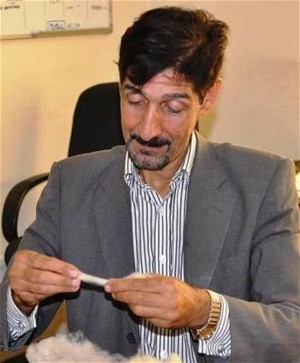
An Afghan businessman is watching the world wake up to the potential of Afghan cashmere
"A revolution in the cashmere sector is happening in Afghanistan. USAID has contributed a lot to the cashmere industry."-Abdul Basir Hotak, a prominent Afghan cashmere trader
5 NOVEMBER 2010
Abdul Basir Hotak, the owner of the Afghan-Macau Cashmere and Leather Processing Company, is witnessing the birth of a vibrant industry that could make Afghanistan a world player in the production of luxury clothing items.
“A revolution in the cashmere sector is happening in Afghanistan,” said Hotak, whose company exports up to 350 metric tons of cashmere annually to make high-quality sweaters, scarves, and other clothing.
With USAID support, Hotak attended an agricultural trade fair in Tajikistan last August to showcase samples of his country’s cashmere at the Afghanistan booth, which also featured sweaters and scarves made from local cashmere. The booth received third place out of more than 60 booths, and Hotak scored a $100,000 business deal with a Tajik businessman.
Hotak is using the deal as a stepping stone to bigger deals in the cashmere industry. He owns a cashmere scouring facility in Hirat and is establishing a de-hairing facility in the western Afghan city with USAID support. The facility will allow Afghan cashmere traders to locally de-hair (remove coarse goat hairs from fine cashmere) rather than sending the raw product to China for processing. The facility will boost the value of Afghanistan’s cashmere abroad and attract Tajik cashmere producers who want to use the state-of-the-art equipment.
Hotak is also engaged in talks with high-end U.S. fashion company Kate Spade to produce woven cashmere scarves and hand-knit pillows with an Afghan women’s organization. USAID helped to build the relationship between Hotak and Kate Spade and has improved the quality of Afghanistan’s cashmere to make such business deals possible. USAID also trained more than 200,000 male and female goat herders in 2010 on the value of cashmere and proper harvesting methods. Prior to the training, many goat herders had no idea that cashmere should be harvested with care because it is such a valuable product.
“The quality of the cashmere I have received has improved significantly,” Hotak said. “I am receiving goat hair that yields up to 60 percent cashmere compared to 45 percent a few years ago. USAID has contributed a lot to the cashmere industry in Afghanistan.”







Comment
Make a general inquiry or suggest an improvement.